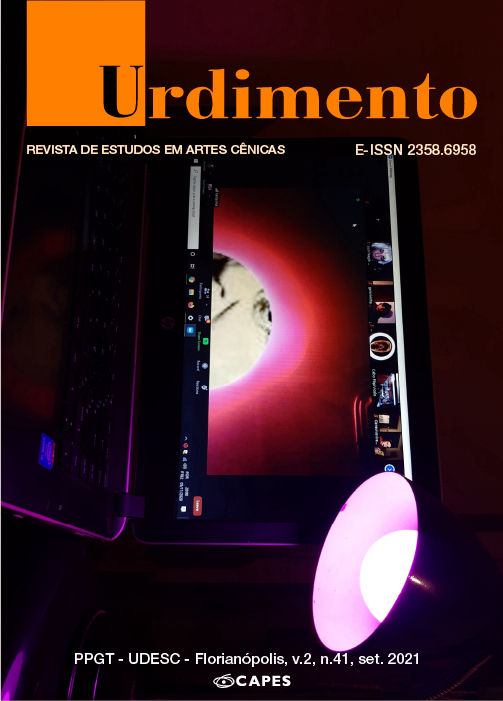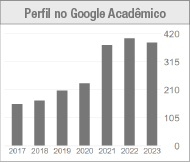The New Woman: Male anxieties and female circumvention in Berlin cabaret
DOI:
https://doi.org/10.5965/1414573102412021e0105Keywords:
New Woman, Cabaret, Typifications, Weimar RepublicAbstract
The New Woman was a complex, multidimensional, heterogeneous and gradual phenomenon that gained strength in Germany during the Weimar Republic. The right to female participation in politics guaranteed by the 1919 Constitution and the influx of women in the labor market generated male tensions about gender roles. Cabaret worked as a commentator of its time and shed light on the masculine anxieties regarding the New Woman, representing them through typifications. This article intends to analyze some of these typifications - evidence of male concerns - in counterpoint to female strategies to circumvent them.
Downloads
References
ANKUM, K. VON (org). Women in the metropolis: gender and modernity in Weimar culture. Berkeley: University of California Press, 1997. kindle edition
APPIGNANESI, Lisa. Cabaret the first hundred years. London: Methuen, 1984.
BAILEY, Peter. Conspiracies of Meaning: Music-Hall and the Knowingness of Popular Culture. The past and present society magazine. No. 144 (Aug, 1994), p. 138-170.
BOAK, Helen. Women in the Weimar Republic. Manchester: Manchester University Press, 2013.
BRECHT, Bertolt. The Messingkauf Dialogues. London: Methuen, 1994.
COHEN, Renato. Performance como linguagem: criação de um tempo-espaço de experimentação. São Paulo: Perspectiva, 2002.
DANIELCZYK, Sandra. Diseusen in der Weimarer Republik: Imagekonstruktionen im Kabarett am Beispiel von Margo Lion und Blandine Ebinger. Bielefeld: Transcript Verlag, 2017.
DOUBLE, Oliver; Wilson, Michael. Brecht and Cabaret. In: THOMPSON, Peter; SACKS, Glendyr. The Cambridge Companion to Brecht. Cambridge: Cambridge University Press, 2006.
FARINA, Willian. The German cabaret legacy in American popular music. Jefferson: McFarland & Company, Inc, 2013.
FECHNER, Charlotte. The Berlin Cabaret & the Neue Frau 1918-1933. München: GRIN Verlag, 2001.
FERRAN. Peter Wigglesworth. The Threepenny Songs: Cabaret and the Lyrical Gestus. Theater, Volume 30, Number 3, Fall 2000, pp. 5-21
GILL, Anton. Dance Between Flames: Berlin Between the Wars. Londres: Endeavour Press, 2015. Kindle Edition.
GORDON, Mel. Voluptuous panic: the erotic world of Weimar Berlin. Los Angeles: Feral House, 2006
GRAF, Rüdiger. Anticipating the Future in the Present: "New Women" and Other Beings of the Future in Weimar Germany. Central European History, vol. 42, no. 4, p. 647–673, 2009.
HAKE, Sabine. In the mirror of fashion. In: ANKUM, Katherine von (org). Women in the metropolis: gender and modernity in Weimar culture. Berkeley: University of California Press, 1997. kindle edition
LEWIS, Beth Irwin. Lustmord: inside the Windows of the Metropolis. In: ANKUM, Katherine von (org). Women in the metropolis: gender and modernity in Weimar culture. Berkeley: University of California Press, 1997. kindle edition
MAFESSOLI, Michel. O imaginário é uma realidade. Revista FAMECOS, Porto Alegre, nº 15, p.74-83, agosto, 2001.
MIZEJEWSKI, Linda. Divine Decadence: Fascism, Female Spectacle, and the Makings of Sally Bowles. Princeton: Princeton University Press, 2014, p.44
PAVIS, Patrice. Dicionário de Teatro. São Paulo: Perspectiva, 2008.
RICHARD, Lionel. Berlim, 1919-1933: a encarnação extrema da modernidade. Rio de Janeiro: J. Zahar, 1993.
RICHIE, Alexandra. Faust’s Metropolis: a history of Berlin. London: William Collins, 2013. Kindle Edition.
RUTTKOWSKI, Wolfgang. Cabaret Songs. Popular Music & Society, 25:3-4,
-71, 2001.
SCHASER, Angelika. Gendered Germany. In: RETALLACK, J. N. (ED.). Imperial Germany, 1871-1918. New York: Oxford University Press, 2008.
SCHMID, Carol. The 'New Woman' Gender Roles and Urban Modernism in Interwar Berlin and Shanghai. Journal of International Women's Studies, 15(1), 1-1, 2014.
SIEG. Katrin. Exiles, Eccentrics, Activists: Women in Contemporary German Theater. Ann Harbor: The University of Michigan Press, 1997.
SIMMEL, George. A Metrópole e a Vida Mental. In: VELHO, Otávio G (org.). O Fenômeno Urbano. Rio de Janeiro: Ed. Guanabara, 1973.
STREVA, Christina. Por um ator-provocador e um professor-criador: uma pesquisa-ação sobre a performance de cabaré. Tese (Doutorado) – Universidade Federal do Estado do Rio de Janeiro, Rio de Janeiro, 2017.
SUTTON, Katie. The Masculine Woman in Weimar Germany. New York: Berghahn Books, 2011.
TURNER, Victor. O processo ritual: estrutura e antiestrutura. Petrópolis: Vozes, 2013.
WIDDIG, Bernd. Culture and inflation in Weimar Germany. Berkeley: University of California Press, 2001.
Downloads
Published
How to Cite
Issue
Section
License
Copyright (c) 2021 Urdimento - Revista de Estudos em Artes Cênicas

This work is licensed under a Creative Commons Attribution 4.0 International License.
Copyright Statement
The articles published by the magazine are free to use. The copyright is all assigned to the magazine. The articles whose authors are identified represent the expression from the point of view of their authors and not the official position of the journal Urdimento. The author (s) undertakes whenever publishing material relating to the article published in Revista Urdimento mention the said publication as follows: This article was originally published by Urdimento magazine in its volume (put the volume), number (put the number) in the year of (put the year) and can be accessed at:
http://www.revistas.udesc.br/index.php/urdimento
This work is licensed under a Creative Commons Attribution 4.0 International License.




